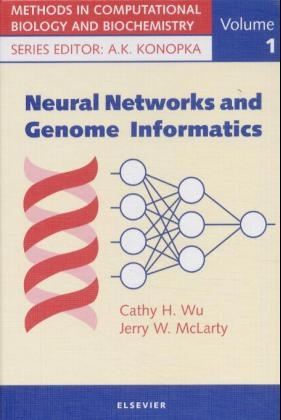
Neural Networks and Genome Informatics
Elsevier Science Ltd (Verlag)
978-0-08-042800-0 (ISBN)
- Keine Verlagsinformationen verfügbar
- Artikel merken
This book is a comprehensive reference in the field of neural networks and genome informatics. The tutorial of neural network foundations introduces basic neural network technology and terminology. This is followed by an in-depth discussion of special system designs for building neural networks for genome informatics, and broad reviews and evaluations of current state-of-the-art methods in the field. This book concludes with a description of open research problems and future research directions.
PART I.
OVERVIEW.
Chapter 1.
Neural Networks for Genome Informatics.
1.1 What Is Genome Informatics?.
1.1.1 Gene Recognition and DNA Sequence Analysis.
1.1.2 Protein Structure Prediction.
1.1.3 Protein Family Classification and Sequence Analysis.
1.2 What Is An Artificial Neural Network?.
1.3 Genome Informatics Applications.
1.4 References.
PART II.
Neural Network Foundations.
Chapter 2.
Neural Network Basics.
2.1 Introduction to Neural Network Elements.
2.1.1 Neurons.
2.1.2 Connections between Elements.
2.2 Transfer Functions.
2.3.1 Summation Operation.
2.3.2 Thresholding Functions.
2.3.3 Other Transfer Functions.
2.4 Simple Feed-Forward Network Example.
2.5 Introductory Texts.
2.6 References.
Chapter 3.
Perceptrons and Multilayer Perceptrons.
3.1 Perceptrons.
3.1.1 Applications.
3.1.2 Limitations.
3.2 Multilayer Perceptrons.
3.2.1 Applications.
3.2.2 Limitations.
3.3 References.
Chapter 4.
Other Common Architectures.
4.1 Radial Basis Functions.
4.1.1 Introduction to Radial Basis Functions.
4.1.2 Applications.
4.1.3 Limitations.
4.2 Kohonen Self-organizing Maps.
4.2.1 Background.
4.2.2 Applications.
4.2.3 Limitations.
4.4 References.
Chapter 5.
Training of Neural Networks.
5.1 Supervised Learning.
5.2.1 Training Perceptrons.
5.2.2 Multilayer Perceptrons.
5.2.3 Radial Basis Functions.
5.2.4 Supervised Training Issues.
5.3 Unsupervised Learning.
5.4 Software for Training Neural Networks.
5.5 References.
PART III.
Genome Informatics Applications.
Chapter 6.
Design Issues - Feature Presentation.
6.1 Overview of Design Issues.
6.2 Amino Acid Residues.
6.3 Amino Acid Physicochemical and Structural Features.
6.4 Protein Context Features and Domains.
6.5 Protein Evolutionary Features.
6.6 Feature Representation.
6.7 References.
Chapter 7.
Design Issues - Data Encoding.
7.1 Direct Input Sequence Encoding.
7.2 Indirect Input Sequence Encoding.
7.3 Construction of Input Layer.
7.4 Input Trimming.
7.5 Output Encoding.
7.6 References.
Chapter 8.
Design Issues - Neural Networks.
8.1 Network Architecture.
8.2 Network Learning Algorithm.
8.3 Network Parameters.
8.4 Training and Test Data.
8.4.1 Network Generalization.
8.4.2 Data Quality and Quantity.
8.4.3 Benchmarking Data Set.
8.5 Evaluation Mechanism.
8.6 References.
Chapter 9.
Applications - Nucleic Acid Sequence Analysis.
9.1 Introduction.
9.2 Coding Region Recognition and Gene Identification.
9.3 Recognition of Transcriptional and Translational Signals.
9.4 Sequence Feature Analysis and Classification.
9.5 References.
Chapter 10.
Applications - Protein Structure Prediction.
10.1 Introduction.
10.2 Protein Secondary Structure Prediction.
10.3 Protein Tertiary Structure Prediction.
10.4 Protein Folding Class Prediction.
10.5 References.
Chapter 11.
Applications - Protein Sequence Analysis.
11.1 Introduction.
11.2 Signal Peptide Prediction.
11.3 Other Motif Region and Site Prediction.
11.4 Protein Family Classification.
11.5 References.
PART IV.
Open Problems and Future Directions.
Chapter 12.
Integration of Statistical Methods into Neural Network Applications.
12.1 Problems in Model Development.
12.1.1 Input Variable Selection.
12.1.2 Number of Hidden Layers and Units.
12.1.3 Comparison of Architectures.
12.1.4 Need for Benchmark Data.
12.2 Training Issues.
12.3 Interpretation of Results.
12.4 Further Sources of Information.
12.5 References.
Chapter 13.
Future of Genome Informatics Applications.
13.1 Rule and Feature Extraction from Neural Networks.
13.2.1 Rule Extraction from Pruned Networks.
13.2.2 Feature Extraction by Measuring Importance of Inputs.
13.2.3 Feature Extraction Based on Variable Selection.
13.2.4 Network Understanding Based on Output Interpretation.
13.2 Neural Network Design Using Prior Knowledge.
13.3 Conclusions.
13.4 References.
Glossary.
Author Index.
Subject Index.
| Erscheint lt. Verlag | 21.9.2000 |
|---|---|
| Reihe/Serie | Methods in Computational Biology and Biochemistry |
| Verlagsort | Oxford |
| Sprache | englisch |
| Gewicht | 550 g |
| Themenwelt | Naturwissenschaften ► Biologie ► Genetik / Molekularbiologie |
| ISBN-10 | 0-08-042800-2 / 0080428002 |
| ISBN-13 | 978-0-08-042800-0 / 9780080428000 |
| Zustand | Neuware |
| Haben Sie eine Frage zum Produkt? |
aus dem Bereich


